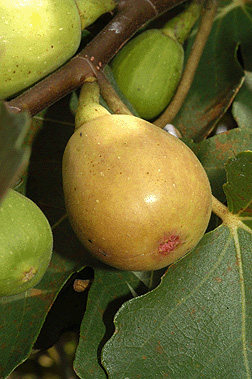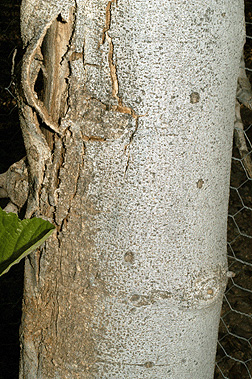common fig Moraceae Ficus carica
Leaf:Alternate, simple, deciduous; 5 inches in diameter, but sometimes larger; palmately lobed with (usually) 5 finger-like lobes, dark green above and lighter green below, petiole exudes a milky sap, somewhat scabrous, margins entire and wavy.
Flower:Either male and female or all female, flowers not showy, green, fleshy and rounded, the actual flowers minute, located on the inner surface of a hollow receptacle. Generally not pollinated in North America because the pollinating wasp is not present.
Fruit:An edible fig; commonly purple-brown but varieties can range from yellow to black, pear- or onion-shaped, and somewhat leathery when mature, succulent, 1 to 2 inches, technically a multiple of tiny drupes; produced in two distinct crops - an early crop that arises from old wood and a late summer crop that arises from new wood; delicious.
Twig:Stout, new growth may be somewhat pubescent, leaf scars nearly round, terminal bud conical, wrapped in a single cap-like scale that leaves a bud scale scar that nearly encircles the twig. Resting buds apparently form after each leaf is formed. On overwintering twigs, flower buds are nearly round.
Bark:Smooth and silvery gray, somewhat warty.
Form:A broadly spreading shrub or small tree with a height of 25 feet and a width greater than or equal to the height.







Notes: